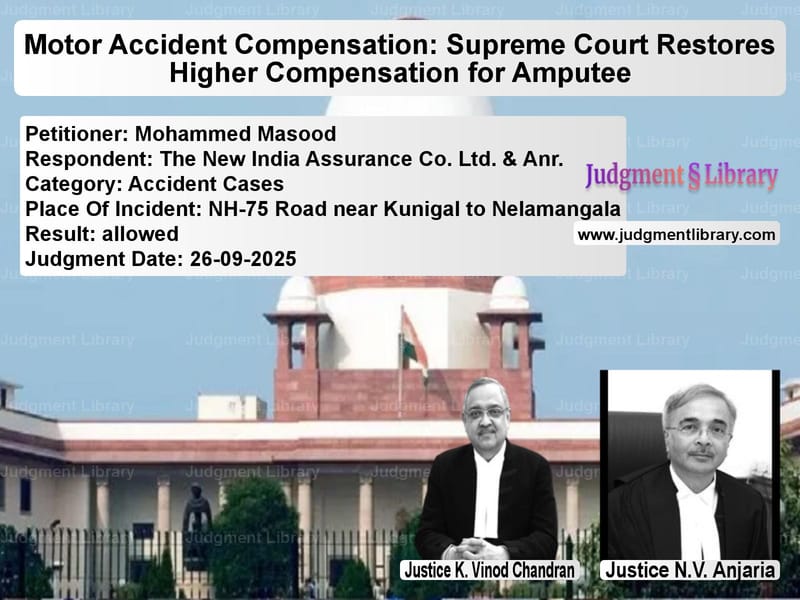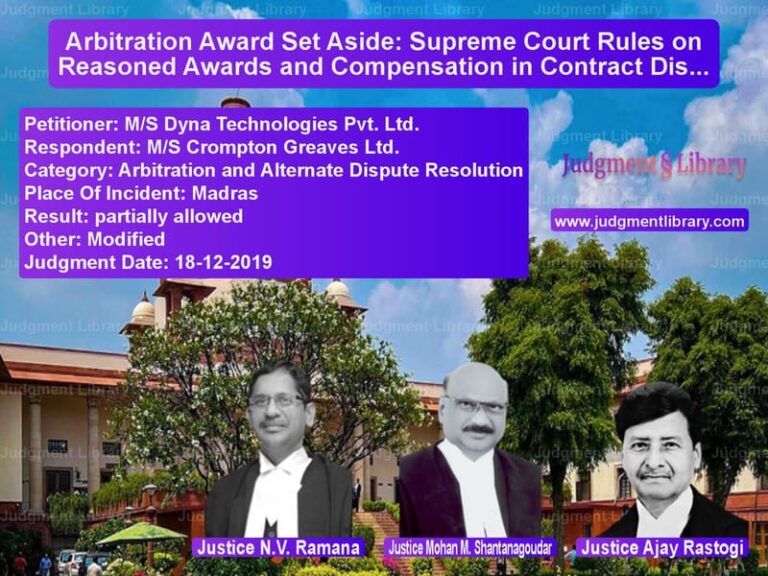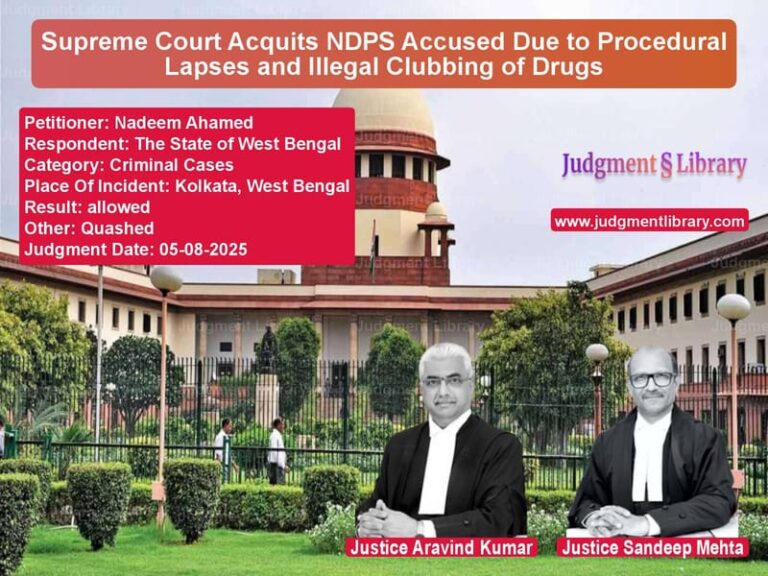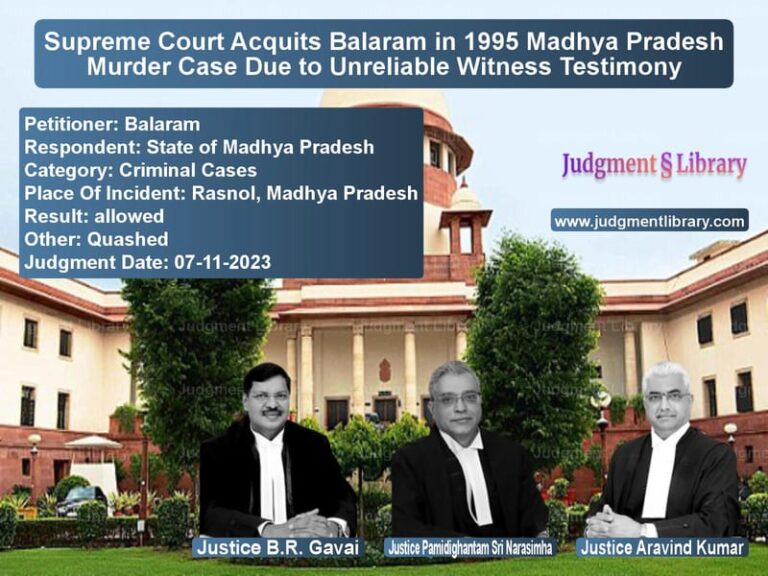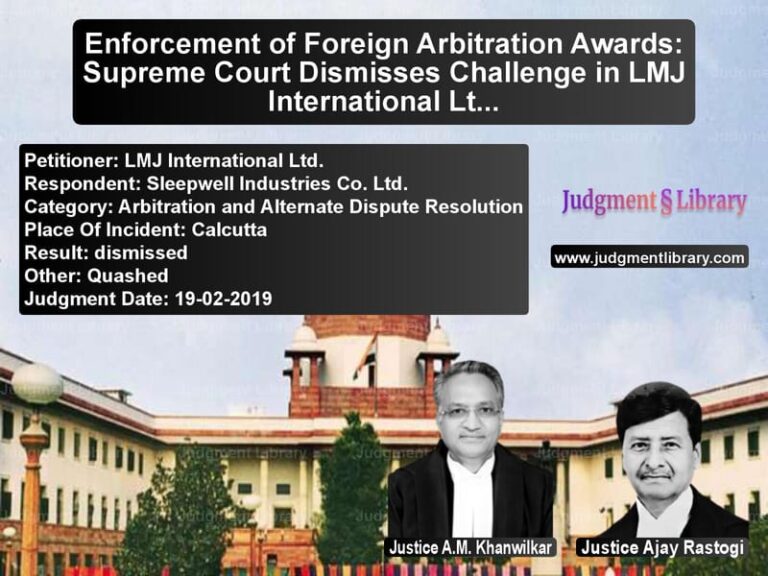Motor Accident Compensation: Supreme Court Restores Higher Compensation for Amputee
In a significant ruling that brings relief to accident victims and clarifies the legal position on compensation calculation, the Supreme Court of India has restored the higher compensation amount awarded to a young man who lost his leg in a road accident. The case involved Mohammed Masood, a 23-year-old loader who suffered a life-altering injury when the lorry he was traveling in met with an accident near NH-75 Road. The judgment overturns the Karnataka High Court’s decision that had substantially reduced the compensation by applying incorrect legal principles, and reinforces the rights of accident victims to receive fair compensation under the Motor Vehicles Act.
The tragic incident occurred on December 1, 2015, when Mohammed Masood was traveling from Kunigal to Nelamangala in a lorry. At about 2:50 AM, the lorry driven at high speed and in a negligent manner dashed with an unknown ongoing vehicle. The appellant sustained severe injuries to his right leg that ultimately required amputation below the knee. This life-changing injury to a young man just beginning his adult life led to a claim petition under Section 166 of the Motor Vehicles Act, 1988, where he sought compensation of Rs. 35,00,000 for his permanent disability and the complete upheaval of his life prospects.
The Motor Accident Claims Tribunal, after examining the evidence, assessed the compensation by taking the monthly income of the appellant at Rs. 9,000. While the claimant himself asserted that his monthly wages were Rs. 15,600, the Tribunal arrived at what it considered a reasonable figure based on the evidence before it. The medical evidence established that the disability of the left lower limb was 70%, but the Tribunal, considering the overall impact on his life and earning capacity, took the disability for the whole body to be 85%. Applying a multiplier of 18, which is standard for victims aged 23 years, the Tribunal awarded a total compensation of Rs. 19,35,400 under various heads including pain and suffering, future loss of income, loss of enjoyment of life, and future medical treatment.
However, the insurance company appealed this decision before the Karnataka High Court, which took a dramatically different approach to calculating the compensation. The High Court reduced the income figure from Rs. 9,000 to Rs. 8,000 per month, citing an unusual justification. The High Court observed in paragraph 10 of its judgment: “Admittedly, as on the date of accident, the claimant was aged about 23 years; though he has contended that he was earning Rs.16,500/- per month, under the Workmen’s Compensation Act, the maximum income that could be considered is only Rs.8,000/- per month. Since this is a case of injury, only 60% of that should be considered for calculating the compensation, which comes to Rs.4,800/- per month.” This reasoning led to the compensation being slashed from Rs. 19,35,400 to just Rs. 10,41,022 – a reduction of nearly Rs. 9 lakh that would have severely impacted the victim’s ability to cope with his disability and rebuild his life.
Mohammed Masood then approached the Supreme Court, challenging the High Court’s judgment. His counsel raised two primary contentions before the apex court. Firstly, they argued that the High Court committed a fundamental error by applying the income criteria from the Workmen’s Compensation Act to a claim filed under the Motor Vehicles Act. Secondly, they contended that the High Court should have added future prospects to the compensation calculation, especially since the injured was below 40 years of age, as established in the landmark Pranay Sethi case.
The Supreme Court, in its judgment delivered by Justices K. Vinod Chandran and N.V. Anjaria, found substantial merit in the first contention. The court clearly stated: “The first limb of submission has substance. The appellant chose to file a claim petition for compensation in respect of injuries he suffered in the accident. After consent by the parties, the Tribunal adjudicated the same and assessed the income to be Rs.9,000/- per month to calculate the amount of compensation accordingly. The Tribunal having determined the compensation on that basis, the High Court misdirected itself in applying the criteria under the provisions of the Workmen’s Compensation Act, 1923 to take the view that the income of the appellant-claimant was liable to be considered at Rs.8,000/-.”
The court emphasized the legal position that once a claimant elects to pursue remedy under the Motor Vehicles Act, the compensation must be assessed according to the principles of that Act, not by reverting to the parameters of the Workmen’s Compensation Act. The judgment quoted extensively from the precedent set in National Insurance Company Limited vs. Mastan and Anr., where the court had explained: “Section 167 of the 1988 Act statutorily provides for an option to the claimant stating that where the death of or bodily injury to any person gives rise to a claim for compensation under the 1988 Act as also the 1923 Act, the person entitled to compensation may without prejudice to the provisions of Chapter X claim such compensation under either of those Acts but not under both. Section 167 contains a non obstante clause providing for such an option notwithstanding anything contained in the 1923 Act.”
The Supreme Court made it clear that the issue had already been settled in the Mastan case, which held that once the remedy under the Motor Vehicles Act was elected by the claimant and the Tribunal adjudicated the compensation by applying its criteria, falling back upon the parameters under the Workmen’s Compensation Act was not permissible. The insurance company could not have raised such a defence seeking to apply the provisions of Workmen’s Compensation Act, as both remedies are distinct and separate.
Regarding the second contention about future prospects, the Supreme Court took a pragmatic view. While acknowledging the legal principle established in Pranay Sethi that future prospects should be added for victims below 40 years, the court noted that the appellant had not filed any appeal to challenge the Tribunal’s judgment initially. It was only the insurance company that had approached the High Court. Therefore, the court decided that it would not be appropriate to entertain this additional claim at this stage.
The Supreme Court’s final ruling was clear and decisive: “In the aforesaid view, the reasons supplied by the High Court in paragraph 10 and consequential reduction in the compensation could not be permitted to stand. The compensation awarded by the Tribunal on the basis of income of Rs.9,000/- has to be restored.” Accordingly, the court set aside the High Court’s judgment and restored the Tribunal’s award of Rs. 19,35,400.
This judgment is significant for several reasons. First, it reaffirms the principle that accident victims who choose to file claims under the Motor Vehicles Act are entitled to have their compensation calculated according to the principles of that Act, without being subjected to the limitations of other statutes like the Workmen’s Compensation Act. Second, it protects the rights of victims against insurance companies seeking to reduce legitimate compensation through technical arguments. Third, it recognizes the devastating impact of permanent disabilities like amputation on young victims and ensures that compensation reflects the true extent of their loss.
The case also highlights the importance of proper legal representation for accident victims, who often come from economically disadvantaged backgrounds and may not fully understand the legal complexities involved in compensation claims. Mohammed Masood’s persistence in challenging the High Court’s decision ultimately led to the restoration of his rightful compensation, which will now help him cope with the lifelong challenges posed by his disability.
For the insurance industry and legal practitioners, this judgment serves as a clear reminder that courts will not allow technicalities to undermine the substantive rights of accident victims. The Motor Vehicles Act is a social welfare legislation intended to provide relief to victims of road accidents, and its provisions must be interpreted in a manner that fulfills this objective. The Supreme Court’s decision reinforces this principle and ensures that compensation calculations remain fair and realistic, reflecting the actual circumstances of each case rather than being constrained by artificial limits from other statutes.
Petitioner Name: Mohammed Masood.Respondent Name: The New India Assurance Co. Ltd. & Anr..Judgment By: Justice K. Vinod Chandran, Justice N.V. Anjaria.Place Of Incident: NH-75 Road near Kunigal to Nelamangala.Judgment Date: 26-09-2025.Result: allowed.
Don’t miss out on the full details! Download the complete judgment in PDF format below and gain valuable insights instantly!
Download Judgment: mohammed-masood-vs-the-new-india-assura-supreme-court-of-india-judgment-dated-26-09-2025.pdf
Directly Download Judgment: Directly download this Judgment
See all petitions in Road Accident Cases
See all petitions in Compensation Disputes
See all petitions in Motor Vehicle Act
See all petitions in Negligence Claims
See all petitions in Motor Insurance Settlements
See all petitions in Judgment by K. Vinod Chandran
See all petitions in Judgment by N.V. Anjaria
See all petitions in allowed
See all petitions in supreme court of India judgments September 2025
See all petitions in 2025 judgments
See all posts in Accident Cases Category
See all allowed petitions in Accident Cases Category
See all Dismissed petitions in Accident Cases Category
See all partially allowed petitions in Accident Cases Category

